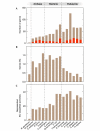A genomic overview of pyridoxal-phosphate-dependent enzymes
- PMID: 12949584
- PMCID: PMC1326353
- DOI: 10.1038/sj.embor.embor914
A genomic overview of pyridoxal-phosphate-dependent enzymes
Abstract
Enzymes that use the cofactor pyridoxal phosphate (PLP) constitute a ubiquitous class of biocatalysts. Here, we analyse their variety and genomic distribution as an example of the current opportunities and challenges for the study of protein families. In many free-living prokaryotes, almost 1.5% of all genes code for PLP-dependent enzymes, but in higher eukaryotes the percentage is substantially lower, consistent with these catalysts being involved mainly in basic metabolism. Assigning the function of PLP-dependent enzymes simply on the basis of sequence criteria is not straightforward because, as a consequence of their common mechanistic features, these enzymes have intricate evolutionary relationships. Thus, many genes for PLP-dependent enzymes remain functionally unclassified, and several of them might encode undescribed catalytic activities. In addition, PLP-dependent enzymes often show catalytic promiscuity (that is, a single enzyme catalyses different reactions), implying that an organism can have more PLP-dependent activities than it has genes for PLP-dependent enzymes. This observation presumably applies to many other classes of protein-encoding genes.
Figures



References
-
- Brushaber K.R., O'Toole G.A. & Escalante-Semerena J.C. ( 1998) CobD, a novel enzyme with L-threonine-O-3-phosphate decarboxylase activity, is responsible for the synthesis of (R)-1-amino-2-propanol-O-2-phosphate, a proposed new intermediate in cobalamin biosynthesis in Salmonella typhimurium LT2. J. Biol. Chem., 273, 2684–2691. - PubMed
-
- Chang C.H. & Frey P.A. ( 2000) Cloning, sequencing, heterologous expression, purification, and characterization of adenosylcobalamin-dependent D-lysine 5,6-aminomutase from Clostridium sticklandii. J. Biol. Chem., 275, 106–114. - PubMed
-
- Chen H.P., Wu S.H., Lin Y.L., Chen C.M. & Tsay S.S. ( 2001) Cloning, sequencing, heterologous expression, purification, and characterization of adenosylcobalamin-dependent D-ornithine aminomutase from Clostridium sticklandii. J. Biol. Chem., 276, 44744–44750. - PubMed
-
- Christen P. & Mehta P.K. ( 2001) From cofactor to enzymes. The molecular evolution of pyridoxal-5′-phosphate-dependent enzymes. Chem. Rec., 1, 436–447. - PubMed
Publication types
MeSH terms
Substances
LinkOut - more resources
Full Text Sources
Other Literature Sources
Research Materials

